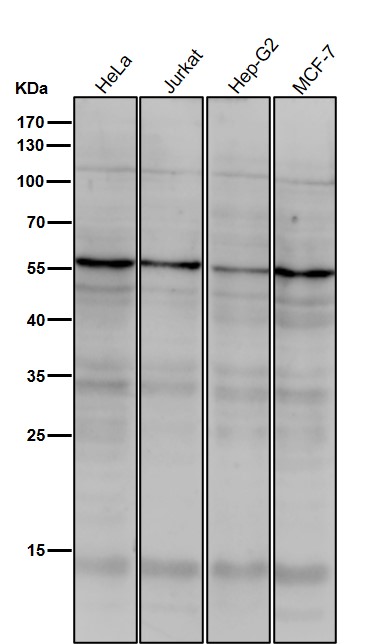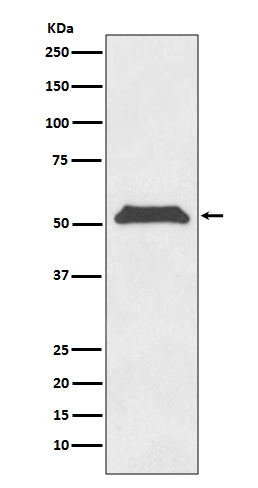

| WB | 咨询技术 | Human,Mouse,Rat |
| IF | 咨询技术 | Human,Mouse,Rat |
| IHC | 咨询技术 | Human,Mouse,Rat |
| ICC | 1/50-1/200 | Human,Mouse,Rat |
| FCM | 咨询技术 | Human,Mouse,Rat |
| Elisa | 咨询技术 | Human,Mouse,Rat |
| Aliases | TERF1; PIN2; TRBF1; TRF1;;TERF1 |
| WB Predicted band size | 50 kDa |
| Host/Isotype | Rabbit IgG |
| Antibody Type | Primary antibody |
| Storage | Store at 4°C short term. Aliquot and store at -20°C long term. Avoid freeze/thaw cycles. |
| Species Reactivity | Human,Mouse |
| Immunogen | A synthesized peptide derived from human TERF1 |
| Formulation | Purified antibody in PBS with 0.05% sodium azide,0.05% BSA and 50% glycerol. |
+ +
以下是关于TRF1抗体的3篇参考文献的简要总结,涵盖其功能研究及实验应用方向:
---
1. **文献名称**:*"Control of telomere length by the human telomeric protein TRF1"*
**作者**:van Steensel, B., & de Lange, T.
**摘要**:该研究通过TRF1抗体进行免疫沉淀和染色实验,揭示了TRF1通过负反馈机制调控端粒长度,证明其过量表达会缩短端粒,而抑制TRF1会导致端粒延长,为端粒长度稳态机制提供了关键证据。
2. **文献名称**:*"TRF1 promotes telomere protection through inhibition of ATM kinase activity"*
**作者**:Okamoto, K., et al.
**摘要**:文章利用TRF1抗体开展蛋白质相互作用分析及免疫荧光实验,发现TRF1通过抑制ATM激酶活性保护端粒免受DNA损伤信号激活,阐明了其在端粒结构维护中的新功能。
3. **文献名称**:*"The telomeric protein TRF1 binds the ATM kinase and is essential for chromosome end stability"*
**作者**:Kishi, S., & Lu, K.P.
**摘要**:研究通过TRF1抗体进行Western blot和共定位分析,证实TRF1与ATM激酶直接结合,并揭示其在维持染色体末端稳定性中的关键作用,为端粒相关疾病(如癌症)的机制研究提供了依据。
---
以上文献均以TRF1抗体为核心实验工具,涵盖功能探索、分子机制及疾病关联研究,建议结合具体实验需求进一步筛选。如需更多方向(如抗体开发或临床转化),可补充说明。
TRF1 (Telomeric Repeat Binding Factor 1) is a key component of the shelterin complex, which safeguards telomeres—the protective caps at chromosome ends. TRF1 binds directly to double-stranded telomeric DNA repeats (TTAGGG)n, facilitating the formation of T-loop structures that prevent telomere degradation and end-to-end fusion. It plays a critical role in regulating telomere length by recruiting helicases and other enzymes to control replication stress and inhibit excessive elongation by telomerase. Dysregulation of TRF1 is linked to genomic instability, accelerated aging, and cancer progression.
TRF1 antibodies are essential tools for studying telomere biology. They enable the detection and localization of TRF1 in techniques like immunofluorescence, Western blotting, and chromatin immunoprecipitation (ChIP). These antibodies help investigate TRF1’s interactions with shelterin partners (e.g., TIN2. POT1) and its role in telomere maintenance, replication fork dynamics, and cellular senescence. Commercially available TRF1 antibodies are often validated for specificity across species (human, mouse, rat) and applications. Researchers use them to explore TRF1’s involvement in diseases, such as cancers with telomere dysfunction, or to assess telomere-related responses to therapies. Proper controls, like siRNA knockdown or TRF1-deficient cells, are recommended to confirm antibody specificity in experimental settings.
×